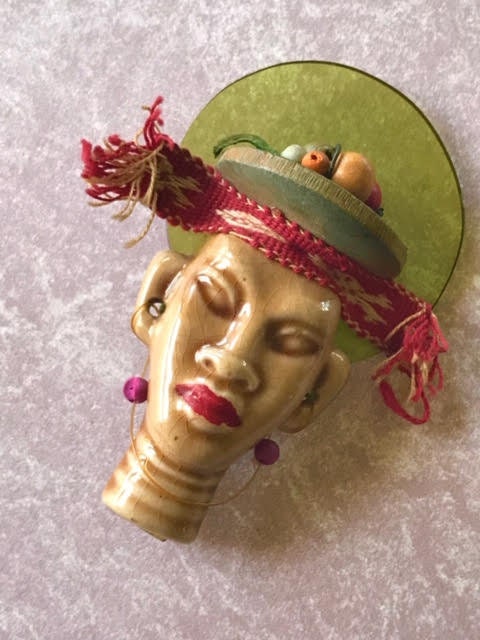
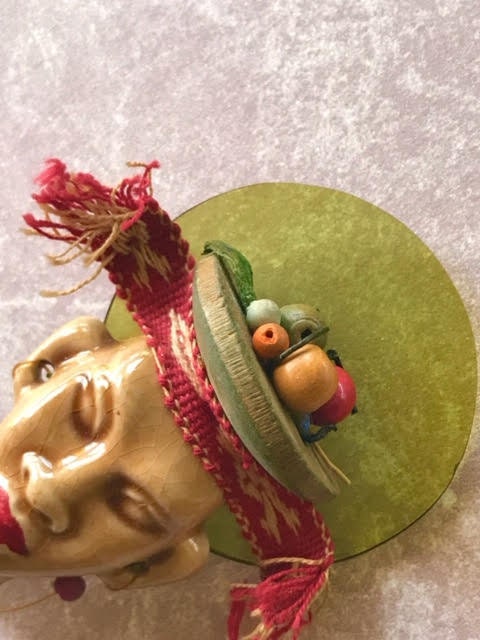

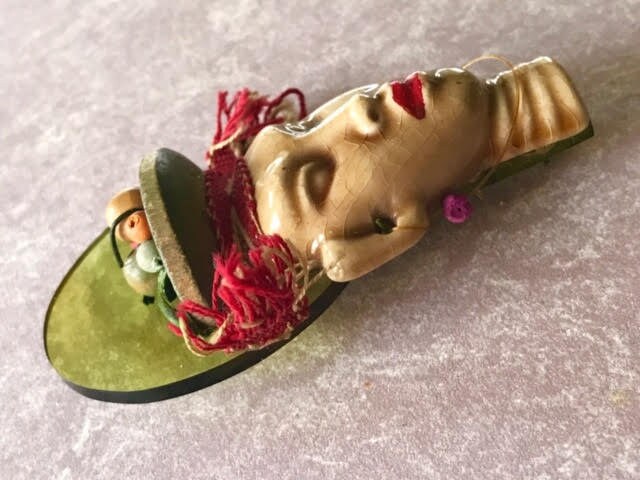

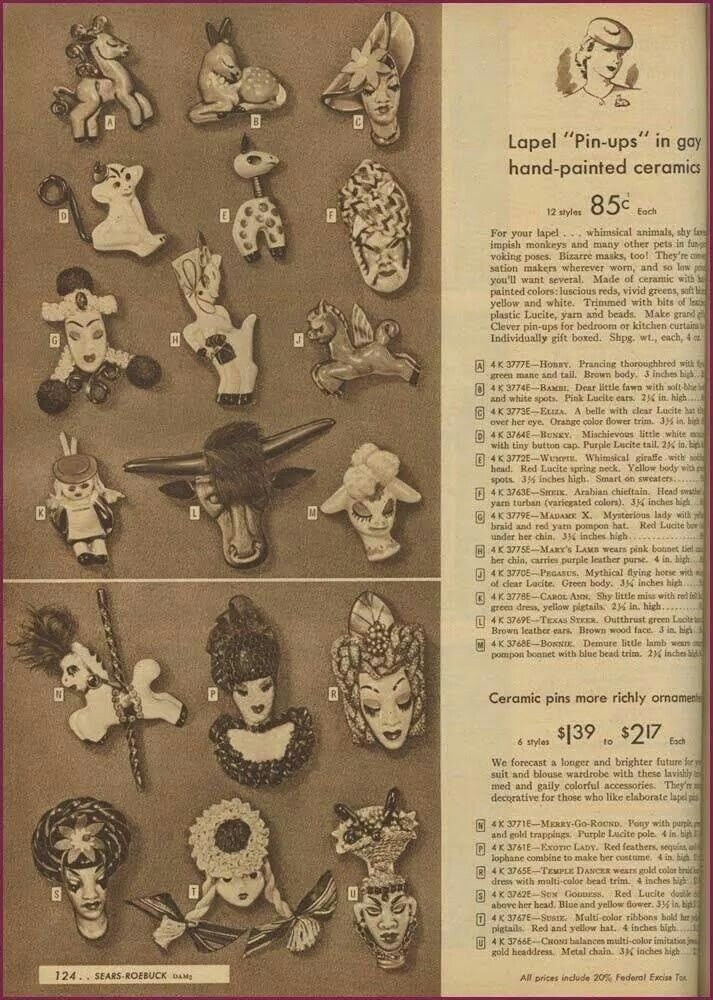
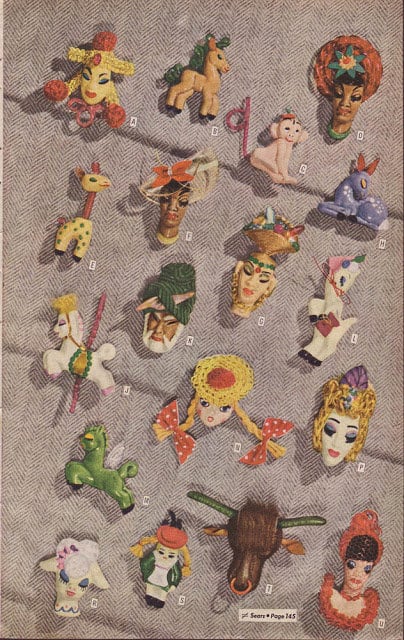
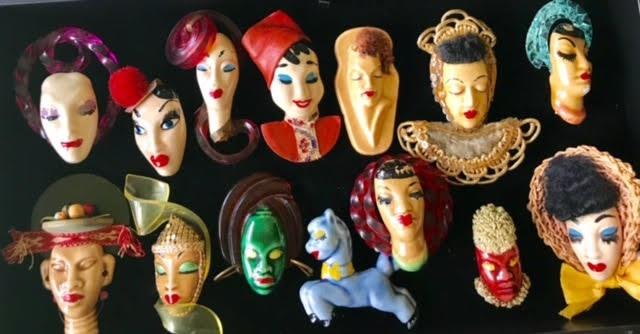
Elzac Victim of Fashion Tribal Style Ceramic and Lucite Pin Brooch Lapel "Pin Up"
Whopping 4.25 X 1.75 inches, this Elzac Lapel Pin Up Brooch features a lady with a twisted Green lucite headpiece which holds a bowl of fruit. Great vintage condition, missing some beads from the original necklace, only 2 are remaining. Face has crazing of the glaze consistent with age. This has never bothered me due to the age of the piece. I have a collection of these that will be listed individually, so see my other listings if you love Elzac! Photos are also part of the description. Please look carefully, I will be glad to send more if needed. This particular lady has the original embedded pin back.
All items are shipped USPS priority mail signature required, fully insured upon completion of transaction.
follow me on Instagram @Maimiesmini
All product photos are of the actual item. Colors may differ slightly from actual product appearance due to differences in products and lighting conditions.
Please contact me if you have specific additional photo requests as photos are part of the description.
Read about Vintage Bakelite and ME in the Pioneer Woman Magazine, Spring Issue here:
https://photos.imageevent.com/kimlovesvintage/pioneerwomanbakelitearticle/ArticlePDF.pdf
I have included copies of the original catalog advertisement from the Sears Catalog 1943.
AntiqueWeek.com posted this awesome article on Elzac
Before Barbie there was Elzac
By Jacqueline Rehmann
Everyone has heard of Barbie. Since her debut at the New York City American Toy Fair in 1959 she has become a toy icon. Barbie creators Ruth and Eliot Handler modeled Barbie after a German design. The Handlers co-founded Mattel with their former employee, Harold Mattson, and the rest is history.
But before Barbie, the Handlers were part of a company named Elzac of Hollywood. Elzac produced whimsical and unique figural costume jewelry brooches during the 1940s. Today these brooches are among the most popular and collectible of all vintage costume jewelry.
At the time they were made, 60 percent of the inventory cost around $1. The higher priced brooches could cost up to $9. The less expensive pieces were featured in Sears catalogs and were advertised as lapel “pin-ups” in “gay, hand painted ceramics.” Higher end pieces, usually hand carved of exotic woods such as ebony, were sold in upscale department stores. Today, collectors willingly pay $100 and sometimes much more for Elzac brooches.
The story begins in 1938, the year the Handlers were married. They settled in Southern California where Ruth worked at Paramount Studios while her husband studied at what would later become the California Institute of the Arts. There he experimented with a novel new material called Lucite. Never lacking for inspiration, Handler’s inquisitive and creative genius found no end of possibilities as he paired Lucite with other materials to make bookends, picture frames, trays, hand mirrors, and other giftware. Ever the entrepreneur, Ruth sold the items herself, taking orders everywhere she went. The items’ popularity was immediate and Eliot Handler Plastics was founded. During this time, Handler worked out of his home. In no time, Handler added costume jewelry to his list of products. Handler’s jewelry caught the eye of Zach Zemby and in September 1941 they formed a company which they named Elzac, cleverly combining their names Eliot and Zach. It was just a few months before the Pearl Harbor invasion.
When the United States entered World War II, businesses everywhere were affected. U.S. involvement had an impact on production quotas of items that were not directly related to the war effort. The New York Times regularly featured articles summarizing directives from the War Protection Board. They noted in one column that even outputs of costume jewelry manufacturers were being governed by guidelines set by the Board. By March of 1942, costume jewelry manufacturers were told to stop making goods using a long list of critical metals with rhodium being expressly forbidden. It was needed to coat reflectors in anti-aircraft search lights. Even the use of rhinestones tapered off as domestic supplies became depleted and European imports were cut off. But the demand for costume jewelry did not diminish. To keep pace with demand, designers and manufacturers found alternative materials from which to fashion jewelry. Sterling silver became a common component of costume jewelry; other materials included wood and ceramic. If rhinestones were featured at all, they were few and far between. It was a perfect storm for the Elzac company because their nontraditional designs, made with nontraditional materials, sold like crazy. While the early Elzac designs were predominantly made of heavily carved wood, almost every thing imaginable would be used to embellish the brooches.
The company flourished even with the labor shortages and material problems associated with the war. They were having a hard time keeping up with the demand but they managed through ingenuity. When they found that they could not count on subcontractors to provide parts or sub-assemblies, they established a complete manufacturing plant which occupied four floors and the basement of two adjoining buildings. Clay mixing machines, and electric and gas kilns were located in the basements; on the next floors, row after row of employees (mostly women) hand painted the novelty figures, flowers, and ceramic jewelry items; some of the brooches were “detoured to receive leather, hair, wood, or Lucite additions before coming back for final inspection” according to a Wall Street Journal article from July, 1944. Metal was used but only sparingly and mostly as accents.
To address the problem of labor shortages, Elzac developed a production line approach to manufacturing. Each person on the line had a specific task and they moved quickly, applying trims or painting. The company also employed a novel, direct from factory to retailer system that had four showrooms located strategically in the Midwest, South, Great Lakes, and New York regions as well as two in Los Angeles. According to company records, Elzac novelty jewelry was sold not only across the country but in Cuba, Hawaii, and Central and South America as well.
Elzac designs evolved from fancy flowers to all types of animals including giraffes, cows, lambs, horses, monkeys, rabbits, and squirrels. Faces followed. And oh those faces! Ornately coiffed women and men are perhaps the most popular of Elzac designs. The women, known as “victims of fashion” because of their over the top outfits and exaggerated features, are surprisingly lightweight considering their size. They can measure 4 to 5in from top to bottom and 2 or more inches wide. Beatrice Weld, a fashion designer and friend of the Handlers, is credited with creating the immensely popular brooches in the likeness of women’s faces. Inspired by the colorful character Carmen Miranda, Weld fashioned faces adorned with plastic fruit, scarves, turbans, enormous hoop earrings, and elaborate neckpieces.
Many Elzac designs were patented to protect them from competitors. Today these patents provide a historic record for collectors. There are at least 17 known patents for Elzac designs which include those for ceramic woman’s head, mule, pony, dog, donkey, baby ducks, boy, girl, bird, and rabbit, among others. Some designs had names like “Daisy” for a girl with long yellow braids; “Eliza”, a belle with clear Lucite hat tilted over her eye; and “Madame X”, a mysterious lady with braids and pompom hat. “Bonnet Head” brooches featured a cap of colored or clear Lucite mounted on a ceramic or wooden head. Elzac also produced a series of twins, including adorable fur-trimmed Eskimos that were featured in Women’s Wear Daily and proved to be very popular. Much more rare among Elzac figural jewelry are the full body brooches, including an Asian-style water carrier. Pin mechanisms were simple affairs, either molded into the ceramic, imbedded into wood, or glued onto the backs of pins.
Unfortunately for collectors, Elzac jewelry was not signed. Pieces were marked with paper or foil tags which were removed before wearing. Every now and then a lucky collector will purchase a piece of jewelry with the tag intact, but that is a rare occurence. The Elzac style is so distinctive and unusual, however, that their designs are well known to collectors.
Elzac was a short-lived chapter in the Handlers’ lives; the heyday only lasted from 1942-44. But what a chapter it was. A multi-million dollar business almost from the beginning, the company employed more than 400 people at its peak. That number included more than a dozen ceramic sculptors and nearly as many wood carvers. Business was good; Hollywood stars were photographed wearing Elzac brooches. The 1944 Sears Catalog featured 12 brooches for the lapel or as “clever pin-ups for bedroom or kitchen curtains.” They were fun and they were affordable.
Returns & Exchanges
I don't accept returns, exchanges, or cancellations
But please contact me if you have any problems with your order.
Reviews (1)
Average:
Nov 26, 2020
Thank you for the beautiful brooch! I really liked it!
